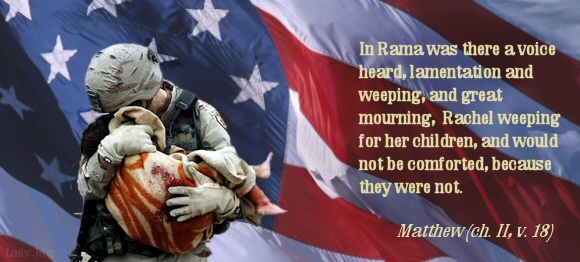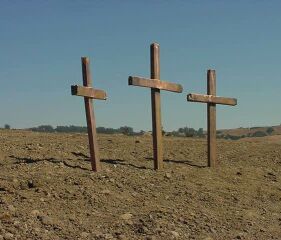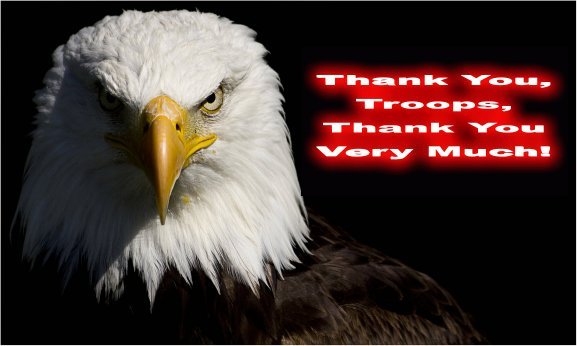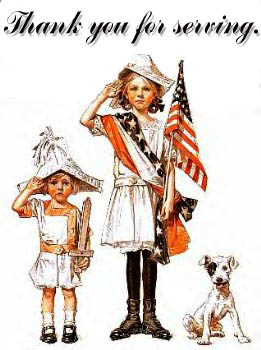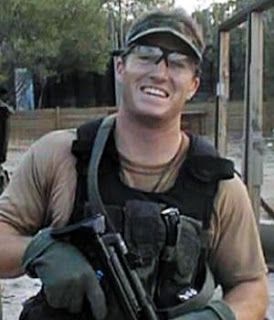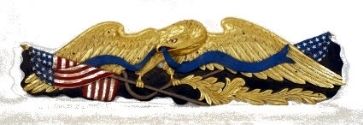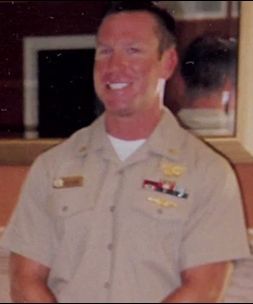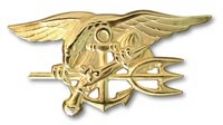
The FReeper Canteen Salutes the
U.S. Marine Corps
On Its 238th Birthday
10NOV1775 – 10NOV2013
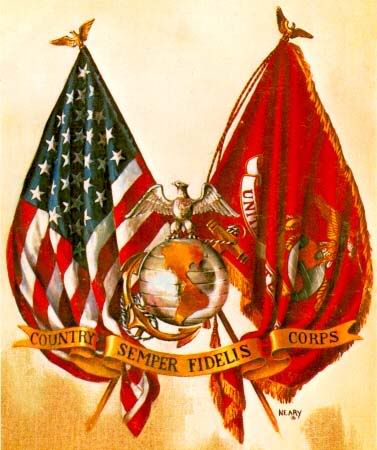
Semper Fidelis!
(Always Faithful!)
O ETERNAL FATHER, we commend to Thy protection and care the members of the Marine Corps. Guide and direct them in the defense of our country and in the maintenance of justice among nations. Protect them in the hour of danger. Grant that wherever they serve they may be loyal to their high traditions and that at all times they may put their trust in Thee; through Jesus Christ our Lord. Amen.
Marine Corps Prayer by Bishop Sherrill
Former Presiding Bishop of the Episcopal Church
And hero of WW I.

Authorized by an Act of Congress dated 10Nov1775, the U.S. Marine Corps has served as an integral arm of the Department of the Navy since the Revolutionary War. From its legendary founding at Tun Tavern in Philadelphia, the Marine Corps has won reknown as America’s "Soldiers of the Sea".
The United States Marine Corps' actions in the Barbary wars led to the line "to the shores of Tripoli" in the opening of the Marines' Hymn. Because of the hazards of boarding hostile ships, Marines' uniforms had a leather high collar to protect against cutlass slashes. This led to the nickname "Leatherneck" for U.S. Marines.
The Marines' most famous action of this period occurred during the First Barbary War (1801-1805) against the Barbary pirates, when William Eaton and First Lieutenant Presley O'Bannon led eight Marines and 500 mercenaries in an effort to capture Tripoli. Though they only reached Derna, the action at Tripoli has been immortalized in the Marines' hymn and the Mameluke Sword carried by Marine officers.
During the War of 1812, Marine naval detachments took part in the great frigate duels that characterized the war, which were the first American victories in the conflict. Their most significant contributions were delaying the British march to Washington, D.C. at the Battle of Bladensburg and holding the center of Gen. Andrew Jackson's defensive line at the defense of New Orleans. By the end of the war, the Marines had acquired a well-deserved reputation as expert marksmen, especially in ship-to-ship actions.
In the Mexican-American War (1846-1848), the Marines made their famed assault on Chapultepec Palace in Mexico City, which would be later celebrated by the phrase "From The Halls of Montezuma" in the Marines' Hymn.

"A Ship without Marines is like a garment without buttons."
Adm. David Dixon Porter, USN in a letter to
Colonel Commandant John Harris, USMC, 1863
During the Spanish-American War (1898), Marines led American forces ashore in the Philippines, Cuba, and Puerto Rico, demonstrating their readiness for deployment. At Guantánamo Bay, Cuba, the Marines seized an advanced naval base that remains in use today. Between 1899 and 1916, the Corps continued its record of vigorous participation in foreign expeditions, including the Philippine–American War, the Boxer Rebellion in China (1899-1901), Panama, the Cuban Pacifications, the Perdicaris Incident in Morocco, Veracruz, Santo Domingo, and the Banana Wars in Haiti and Nicaragua. The experience and expertise gained in counter-insurgency and guerrilla operations during this period were consolidated into the Small Wars Manual.

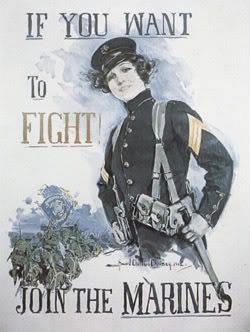
During World War I, veteran Marines served a central role in the late American entry into the conflict. Unlike the Army, the Marine Corps had a deep pool of officers and NCOs with battle experience, and experienced a smaller expansion. The Fifth and Sixth Marine Regiments fought their way to everlasting glory at Belleau Wood, creating the Marines' reputation in modern history. While its previous expeditionary experiences had not earned it much acclaim in the Western world, the Marines' ferocity and toughness in France earned them the respect of the Germans, who rated them of storm-trooper quality. The Corps had entered the war with 511 officers and 13,214 enlisted personnel, and by 11 November 1918 had reached a strength of 2,400 officers and 70,000 men.
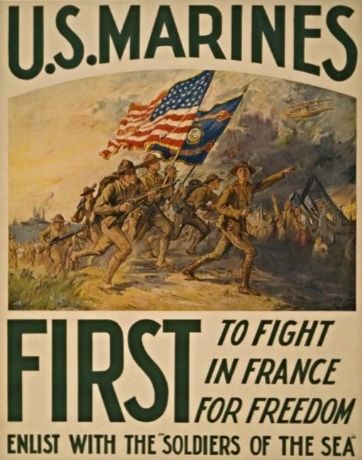

"Retreat Hell! We've Just got here!"
Attributed by MajGen Ben Fuller to Col Frederick M. "Dopey" Wise
CO 2d Bn., 5th Marines, 2dDiv, AEF in France.
On being informed that the French troops were retreating and being advised to do likewise, Wise reportedly erupted with an expletive.
"Come on, you sons of bitches! Do you want to live forever?"
GySgt. Daniel J. "Dan" Daly, USMC (MOH)
Near Lucy-le-Bocage as he led the 6th Marines'
Attack into Belleau Wood, 6 June 1918
"I have only two men out of my company and 20 out of some other company. We need support, but it is almost suicide to try to get it here as we are swept by machine gun fire and a constant barrage is on us. I have no one on my left and only a few on my right. I will hold."
1stLt. Clifton B. Cates, USMC in Belleau Wood, 19 July 1918
"The deadliest weapon in the world is a Marine and his rifle."
Gen. John J. "Black Jack" Pershing, U.S. Army
Commander of American Forces in World War I
"What shall I say of the gallantry with which these Marines have fought! Of the slopes of Hill 142; of the Mares Farm; of the Bois de Belleau and the Village of Bouresches stained with their blood, and not only taken away from the Germans in the full tide of their advance against the French, but held by my boys against counter attacks day after day and night after night. I cannot write of their splendid gallantry without tears coming to my eyes."
MajGen James G. Harbord, USA, in his book, "Leaves from a War Diary"

Between the World Wars, the Marine Corps was headed by Commandant John A. Lejeune, and under his leadership, the Corps presciently studied and developed amphibious techniques that would be of great use in World War II. Many officers, including Lt. Col. Earl Hancock "Pete" Ellis, foresaw a war in the Pacific with Japan and took preparations for such a conflict. Through 1941, as the prospect of war grew, the Corps pushed urgently for joint amphibious exercises and acquired amphibious equipment that would prove of great use in the upcoming conflict.
In World War II, the Marines played a central role in the Pacific War, executing a series of daring amphibious landings on such islands as Guadalcanal, Bougainville, Tarawa, Guam, Tinian, Saipan, Peleliu, Iwo Jima, and Okinawa.
"Casualties many; Percentage of dead not known;
Combat efficiency; we are winning."
Colonel David M. Shoup, USMC
Tarawa, 21 November 1943.
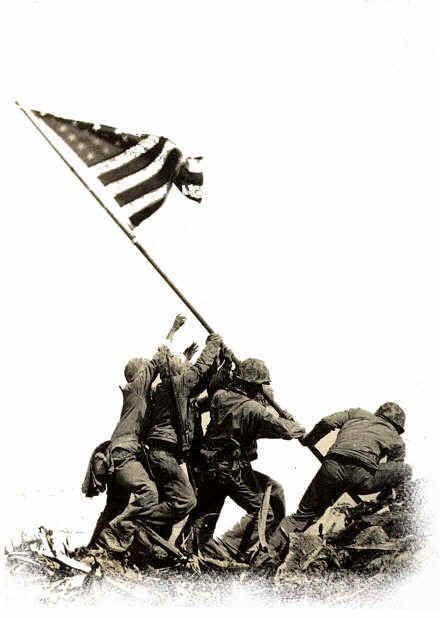
During the battle of Iwo Jima, photographer Joe Rosenthal took the famous photograph of five Marines and one Navy Corpsman raising the American flag on Mt. Suribachi. Secretary of the Navy James Forrestal, having come ashore earlier that day, said of the flag raising, "...the raising of that flag on Suribachi means a Marine Corps for the next five hundred years." The acts of the Marines during the war added to their already significant popular reputation. By war's end, the Corps expanded from two brigades to six divisions, five air wings, and supporting troops, totaling about 485,000 Marines. In addition, 20 defense battalions and a parachute battalion were raised. Nearly 87,000 Marines were casualties during World War II (including nearly 20,000 killed), and 82 were awarded the Medal of Honor.
"By their victory, the 3rd, 4th and 5th Marine Divisions and other units of the Fifth Amphibious Corps have made an accounting to their country which only history will be able to value fully. Among the Americans who served on Iwo Island, uncommon valor was a common virtue."
Admiral Chester W. Nimitz, U.S. Navy
Despite Secretary Forrestal's prediction, the Corps faced an immediate institutional crisis following the war due to the low budget. Army generals pushing for a strengthened and reorganized defense establishment also attempted to fold the Marine mission and assets into the Navy and Army. Drawing on hastily assembled Congressional support, the Marine Corps rebuffed such efforts to dismantle the Corps, resulting in statutory protection of the Marine Corps in the National Security Act of 1947. Shortly afterward, in 1952 the Douglas-Mansfield Bill afforded the Commandant an equal voice with the Joint Chiefs of Staff on matters relating to the Marines and established the structure of three active divisions and air wings that remains today.

The Korean War (1950-1953) saw the hastily formed First Provisional Marine Brigade holding the defensive line at the Pusan Perimeter. To execute a flanking maneuver, General Douglas MacArthur called on Marine air and ground forces to make an amphibious landing at Inchon. The successful landing resulted in the collapse of North Korean lines and the pursuit of North Korean forces north near the Yalu River until the entrance of the People's Republic of China into the war. Chinese troops surrounded, surprised and overwhelmed the overextended and outnumbered American forces. X Corps, which included the 1st Marine Division and the Army's 7th Infantry Division, regrouped and inflicted heavy casualties during their fighting withdrawal to the coast, now known as the Battle of Chosin Reservoir.
"Don't you forget that you’re Marines - First Marines! Not all the communists in hell can overrun you!"
Col Lewis B. "Chesty" Puller, USMC rallying his
First Marines near Chosin Reservoir, Korea
December 1950
"I’m going to fight my way out, I’m going to take all my equipment and all my wounded and as many dead as I can. If we can't get out this way, this Division will never fight as a unit again."
MajGen Oliver P. Smith, CG, lstMarDiv, Korea, 1950, to LtGen Ned Almond, USA, X Corps, who suggested Smith's division escape the Chosin Reservoir by letting "every man go out on foot by himself."
"This was the first time that the Marines of the two nations had fought side by side since the defence of the Peking Legations in 1900. Let it be said that the admiration of all ranks of 41 Commando for their brothers in arms was and is unbounded. They fought like tigers and their morale and esprit de corps is second to none."
Lt Col. D.B. Drysdale, Royal Marine Commandos
Commanding 41 Commando, Chosen Reservoir
On the 1st Marine Division
Marines would continue a battle of attrition around the 38th Parallel until the 1953 armistice. The Korean War saw the Corps expand from 75,000 regulars to a force of 261,000 Marines, mostly reservists. 30,544 Marines were killed or wounded during the war and 42 were awarded the Medal of Honor.

The Marine Corps served an important role in the Vietnam War taking part in such battles as Da Nang, the Relief of Hue City, and the Battle of Khe Sanh. Marines operated in the Northern I Corps Region of South Vietnam. While there, they were constantly engaged in a guerrilla war against the National Front for the Liberation of South Vietnam (NLF) and an intermittent conventional war against the North Vietnamese Army (NVA). Portions of the Corps were responsible for the less-known Combined Action Program (CAP) that implemented unconventional techniques for counter-insurgency and worked as military advisors to the Republic of Vietnam Marine Corps. Marines were withdrawn in 1971, and returned briefly in 1975 to evacuate Saigon and attempt a rescue of the crew of the Mayagüez.
"Courage is endurance for one moment more…"
Unknown Marine Second Lieutenant in Vietnam
Prior to the wars in Iraq and Afghanistan, Vietnam had been the longest war for Marines. By its end, 13,091 had been killed in action, 51,392 had been wounded, and 57 were awarded Medals of Honor. Due to policies concerning rotation, more Marines were deployed for service during Vietnam than were during World War II.

The Iraqi invasion of Kuwait in August 1990 led to the largest movement of Marine forces since World War II. Between August 1990 and January 1991, 24 infantry battalions, 40 squadrons (more than 92,000 Marines) deployed to the Persian Gulf as part of Operation Desert Shield. The air campaign of Operation Desert Storm began Jan. 16, 1991, followed by the main overland attack Feb. 24 when the 1st and 2nd Marine Divisions breached the Iraqi defense lines and stormed into occupied Kuwait. Meanwhile, the threat from the sea in the form of Marine Expeditionary Brigades held 50,000 Iraqis in check along the Kuwait coast. By the morning of Feb. 28, 100 hours after the ground war began, the Iraqi army was no longer a threat.
"I can't say enough about the two Marine divisions. If I use words like 'brilliant', it would really be an under-description of the absolutely superb job that they did in breaching the so-called 'impenetrable barrier'. It was a classic - absolutely classic- military breaching of a very, very tough minefield, barbed wire, fire trenches-type barrier."
Gen. Norman Schwarzkopf, U. S. Army Commander
Operation Desert Storm, February 1991

Today's Marines remain a vital link in America's fighting forces on land, at sea and in the air. They pride themselves on professionalism, brotherhood, esprit de corps and on being "First To Fight". They served with distinction on the ground and in the air above Iraq and Afghanistan. They stand ready to go again into battle to protect and defend our cherished Freedoms. They represent all that is good in the United States of America.
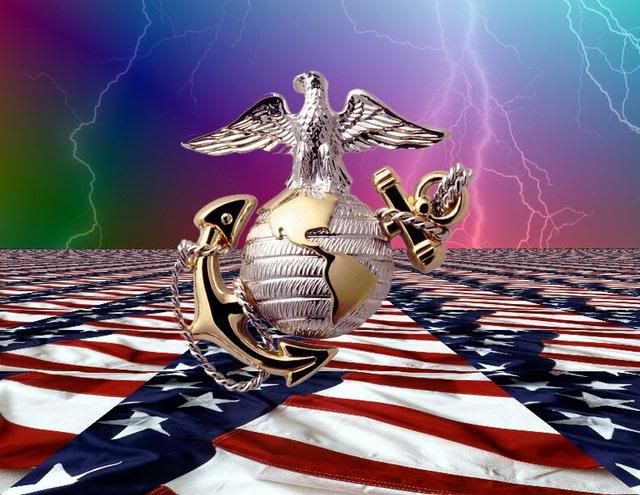
"I love the Corps for those intangible possessions that cannot be issued: pride, honor, integrity, and being able to carry on the traditions for generations of warriors past."
Cpl. Jeff Sornig, USMC; in Navy Times, November 1994

"These are my recruits. I will train them to the best of my ability. I will develop them into smartly disciplined, physically fit, basically trained Marines, thoroughly indoctrinated in love of Corps and country. I will demand of them, and demonstrate by my own example, the highest standards of personal conduct, morality, and professional skill."
"Drill Instructor’s Creed" as it appeared in the
Parris Island "Boot" newspaper, Aug. 31, 1956

The Marine Corps Hymn
U.S. Marine Corps Band
(Click)
National Emblem March
(Click)
Eternal Father, Strong to Save
U.S. Marine Corps Band and Choir
(Click)

Canteen Mission Statement:
"Showing support and boosting the morale of
our military and our allies' military
and family members of the above.
Honoring those who have served before."
Please remember that The Canteen is here to
support and entertain our troops and
veterans and their families, and is family friendly.
|
|
|
|



















